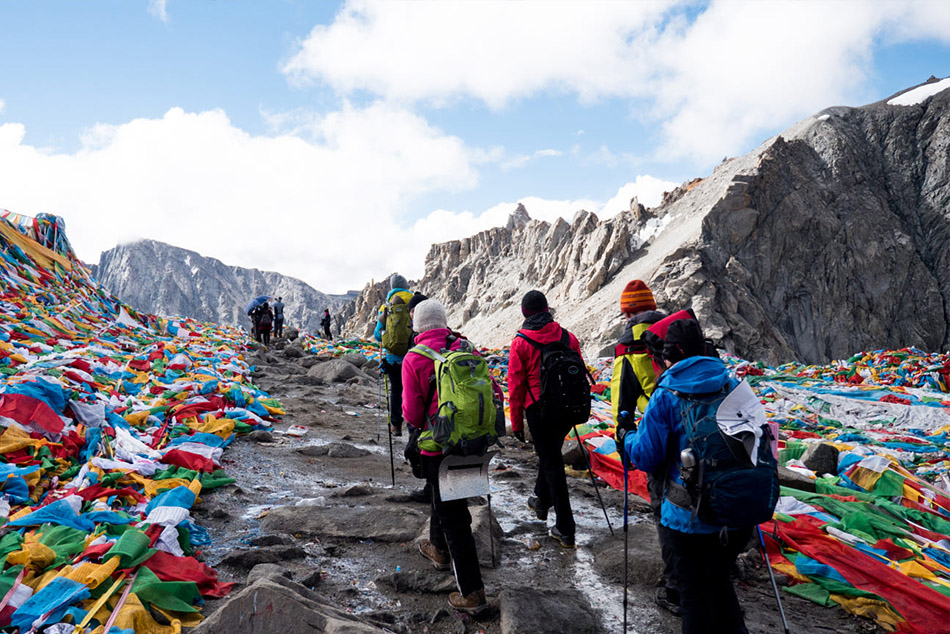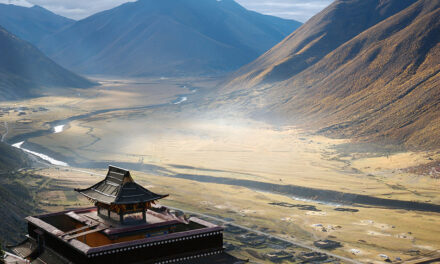Mount Kailash, located in the remote western region of Tibet, is a place of immense spiritual significance and natural beauty. Known as the abode of Lord Shiva in Hinduism and as the center of the universe in Buddhism, Kailash has attracted pilgrims and adventurers for centuries. This Travel guide to kailash provides you with all the essential information you need to plan a memorable journey to this sacred mountain.
Introduction on Kailash
Mount Kailash, also known as Gang Rinpoche or Kangrinboqê, rises majestically at an altitude of 6,638 meters (21,778 feet) in the Trans-Himalayan region. The mountain is revered by Hindus, Buddhists, Jains, and followers of the ancient Bon religion. It holds profound spiritual significance and is believed to be the axis mundi, connecting heaven and earth.
Getting to Kailash
Reaching Kailash requires careful planning due to its remote location. The nearest major city is Lhasa, the capital of Tibet, which can be accessed by air from various international airports. From Lhasa, travelers can choose to travel overland or take a domestic flight to reach the town of Darchen, the starting point for the Kailash pilgrimage.
Accommodation options in the area range from basic guesthouses to more comfortable hotels. It is advisable to make prior arrangements, especially during the peak pilgrimage season.
Sacred Mount Kailash
Legends and myths surround Mount Kailash, adding to its mystical aura. The mountain is believed to be the site of numerous spiritual and supernatural events. Pilgrims undertake the arduous parikrama, or circumambulation, around the mountain, which is considered a sacred ritual in Hinduism and Buddhism.
Kailash Mansarovar Yatra
The Kailash Mansarovar Yatra is a pilgrimage that holds immense religious significance for Hindus and Buddhists. The Yatra involves the circumambulation of Mount Kailash and the sacred Mansarovar Lake. The journey is physically demanding, but it offers a unique opportunity for spiritual growth and self-discovery.
The Yatra typically takes around 15-20 days to complete, and it follows a specific route that includes various stops and campsites. Prior permits and registrations are required to undertake the Yatra, and it is usually organized by authorized tour operators.
Things to do in Kailash
Apart from the pilgrimage, there are several other attractions and activities in the Kailash region. Exploring the Mansarovar Lake, with its crystal-clear waters reflecting the surrounding mountains, is a must-do. The area is also home to several ancient monasteries, such as Chiu and Thailong.
For adventure enthusiasts, nearby trekking routes and peaks offer breathtaking views and opportunities for exploration. Additionally, interacting with the local Tibetan communities and experiencing their unique culture can provide valuable insights into the region.
Best time to visit Kailash
The best time to visit Kailash is during the summer months, from May to September when the weather is relatively mild. The pilgrimage season, which coincides with the Saga Dawa festival, attracts a large number of devotees, adding to the spiritual atmosphere. It is important to note that the weather can be unpredictable, and travelers should be prepared for sudden changes in conditions.
Cultural and Local Insights
The Kailash region is rich in culture and heritage. The local Tibetan people have a deeply rooted spiritual tradition and maintain their customs and traditions with great reverence. Engaging with the locals can provide a deeper understanding of their way of life and their strong connection to the sacred mountain.
Tips for a Successful Kailash Trip
To ensure a successful and safe journey to Kailash, it is essential to be well-prepared. Some key tips include packing essential items such as warm clothing, sturdy footwear, and altitude sickness medication. Acclimatization is crucial due to the high altitude, and it is recommended to consult a healthcare professional before the trip.
Respecting the local customs and traditions, following the guidelines set by the authorities, and being mindful of the fragile environment are essential aspects of a responsible pilgrimage.
Safety and Security
While Kailash is a place of spiritual significance, it is important to prioritize personal safety during the trip. Travelers should be aware of the potential risks associated with high altitude and extreme weather conditions. It is advisable to have travel insurance that covers emergency medical evacuation.
Medical facilities in the area are limited, and it is crucial to carry a basic first aid kit. Additionally, being vigilant about personal belongings and following the advice of local authorities can help ensure a secure journey.
Conclusion of Travel guide to kailash
A journey to Kailash is a profound and transformative experience that combines natural beauty, spiritual awakening, and cultural immersion. The mountain’s timeless allure and the devotion of fellow pilgrims create an atmosphere of deep reverence and reflection. Whether you embark on the Kailash Mansarovar Yatra or explore the region independently, this sacred destination offers a remarkable adventure for the mind, body, and soul.
FAQs
- How long does it take to complete the Kailash Mansarovar Yatra?
- The Kailash Mansarovar Yatra typically takes around 15-20 days to complete, depending on the specific itinerary.
- Are there any age restrictions for the Kailash pilgrimage?
- While there are no strict age restrictions, the pilgrimage involves physically demanding treks and high altitudes. It is advisable for participants to be in good health and consult with a healthcare professional before undertaking the journey.
- Is it possible to visit Kailash independently, without a tour group?
- Yes, it is possible to visit Kailash independently, but it requires careful planning and obtaining the necessary permits. Joining a tour group is recommend for ease of logistics and guidance during the pilgrimage.
- Can I take photographs during the Kailash Yatra?
- Yes, photography is allow during the Kailash Yatra. However, it is important to be respectful of the sacred sites and seek permission from the locals before taking photographs of individuals.
- What are the visa requirements for traveling to Kailash?
- Traveling to Kailash requires obtaining a valid Tibet Entry Permit from the Chinese authorities. It is advisable to consult with a travel agency or tour operator for assistance in obtaining the necessary permits.














